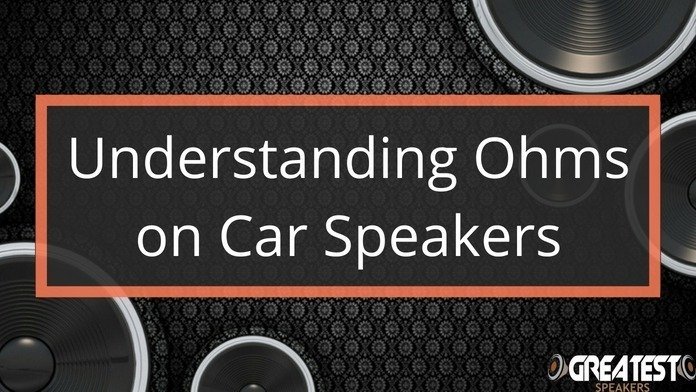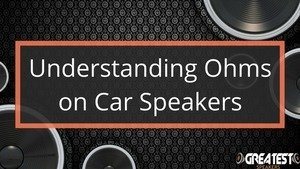What Does Ohm Mean for Speakers and What’s Impedance Anyways?
Welcome to the short Master Class on What does Ohm Mean for Speakers and Impedance!
The quick preview Ohms aka Speaker Impedance is important for your audio system but you don’t need to worry about it because there are some wiring hacks that will help you even if you got the wrong one.
Look:
Speaker ohms or impedance are the resistance that the speakers put in front of the power. The higher the ohm (impedance) more power is needed but the music will sound better and cleaner.
The most common impedance numbers are 2 ohm, 4 ohm and 8 ohm while the 4 ohm is the standard.
By scrolling down you will find out which impedance is the best and which one should you choose for your vehicle. Put it to good use.
Show me already!
[lwptoc]What Exactly Are “Ohms”?
In the most literal definition, ohms (Symbolized as Ω) is the term used to represent the impedance of a speaker. The impedance of a speaker is simply put, the resistance of the flow of electricity. The higher the ohms, the higher the resistance, the lower the ohms, the lower the resistance. Simple, right?
To give you an analogy, let’s imagine that the music you are listening to is water. If a speaker has a lower impedance, it means the “water pipes” are larger and wider, allowing more water to pass through without resistance. On the other hand, speakers with a higher impedance will represent a smaller, thinner water pipe, letting less water through and struggling to do so.
But what does this mean exactly? How does knowing resistance of an electrical current help me make a better decision when purchasing new speakers, and which is the better choice for me? Let’s break it down into a small FAQ to help you understand this concept a little more…
What Are the Most Popular Choices?
You can find speaker impedance ratings that range from 2 ohms all the way up to 8 ohms and beyond, but in the world of car audio, the two most common impedances that you will come across are 2 ohms and 4 ohms.
In car audio technology, 4 ohms tends to be the norm.
Which Is Better?
Logic would tell you that 2 ohms is the better option, as the lower impedance will mean less resistance to the flow of electricity, and that’s got to be a good thing, surely?
To make matters a little bit more confusing than they already are, the answer is, it depends. You can ask two different people whether they can hear an audible difference between music played through a 2 ohms speaker or a 4 ohms speaker (assuming the wattage is the same) and they could both give you completely different responses. It completely depends on the individual (and how much of an audiophile they are), but generally speaking, most people cannot tell the difference between the two.
With all of that being said, there have to be some technical differences between the two, so what is the difference between the two on a technical level?
2 ohm speaker impedance will typically produce a louder sound than a 4 ohm impedance would (again, assuming the wattage is the same) but there is a slight decrease in sound quality when played at louder volumes. Whether you can hear the difference in sound quality is again, down to the individual, but in most cases, the difference is there.
With 4 ohm speaker impedance, you do lose a little bit of mids and treble, but the sound quality tends to be slightly better overall. Does that mean a 4 ohm speaker impedance is the better choice? Who knows!
So, Which One Should I Choose?
Luckily, we do have an actual answer for this one. When purchasing new speakers, or a new amplifier, you need to make sure that the impedance between the two matches. If your amplifier runs an impedance of 2 ohms, you will need speaker impedance that is equal to that. If your amplifier has an impedance of 4 ohms, the same applies and you will need speakers that are equal to that.
The number that is presented in the speaker or amplifiers manual is simply an average, not an exact number. The impedance of a speaker will change constantly throughout a piece of music as the pitch of the notes changes. For example, a low E on a bass guitar will require a lower impedance than say a high F on a violin.
With that being said, as long as the number that is indicated on the amplifier and the speaker’s specification manual match, you will have no problems at all.
Rock On!
What Else Do I Need to Know?
Knowing the impedance that your amplifier can push is important to know when purchasing new speakers or subwoofers for your system, as choosing the wrong impedance equipment and overworking your amplifier can lead to the amplifier burning out.
However, the impedance is not the only thing that you need to take into consideration. Knowing the maximum RMS power rating of the amplifier is also an important figure that you must match up to your speakers and subwoofers. Don’t ever use the maximum (or peak) power rating when matching up your amp and speakers as this is not a true representation of the power output of a piece of equipment.
Once you understand the impedance and the RMS power rating of your amplifier, you can make your decisions without ever having to worry about them not working together, or them causing any issues in the future.
Hopefully, this short breakdown of speaker impedance has helped you to wrap your head around what it is, why it’s important and which one you should choose. “Ohms” is an important aspect of audio technology, but they aren’t the “be all end all”, so don’t beat you up over the choice. Like we said, the difference is honestly not that noticeable, so if you are building a system from the ground up, just make sure that the impedance of your speakers and amps match, and you will be fine.
FAQ on Speaker’s Impedance:
Are 4 ohm speakers the most popular car audio speakers?
Yes it seems to be that the 4 ohm speakers are the most popular among car audio speakers.
What’s the difference between 4 ohm speakers and 8 ohm speakers?
The differences between 4 ohm speakers and 8 ohm speakers is the ohm rating and power output. Here’s a good rule of thump to keep in mind higher the subwoofer impedance (electrical resistance) or ohm rating (load impedance) more power is needed to make the speaker sound louder. In essence the car amplifier (car amplifiers) have to work harder when the ohm is bigger.
What due good quality 4 ohm car speakers have to have?
Here’s a list of things to check out before buying: voice coil, output transistors, speaker terminals and how can they handle full power.
What are ohms in speakers? What Does Ohm Mean
What is ohm in speakers? This is how speaker ohms explained. It’s the impedance of the speaker (aka their resistance value). The most common impedances would be 2 ohm, 4 ohm and 8 ohm. Occasionally there are 1 ohm speakers.
Are higher ohms better for speakers?
Yes higher ohm speakers are somewhat better than lower ones because they can deliver a much cleaner sound quality. Lower ohm speakers on the other hand are more efficient and don’t get hot.
Do you want higher or lower ohms for speakers?
If you value pristine sound quality then you can choose a higher ohm speaker. If you don’t have much space for handling over heating then choose lower ohm speaker.
Is higher or lower ohms better?
Higher ohms deliver a cleaner sound quality and lower ohms require less power and produce less heat so it’s up to the user to decide.
Related Articles from Greatest Speakers:
Last Updated on April 18, 2024 by Brian Beasley




